|
KLONDIKE GOLD RUSH
SKAGWAY, DISTRICT OF ALASKA — 1884-1912: Building the Gateway to the Klondike Historical and Preservation Data |

|
Part III
PRESERVING THE DREAM
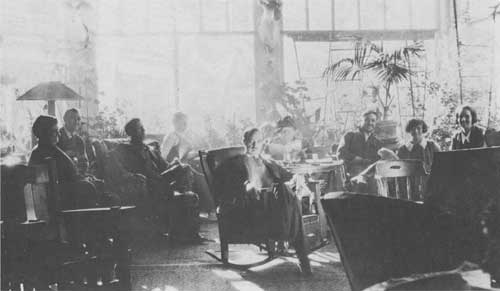
Chapter 6
PRESERVATION IN SKAGWAY
In a sense, preservation in Skagway began the day the first stampeders arrived at Skagway Bay. Propelled north by the momentous Klondike gold rush, the participants realized that they were taking part in a major historical event. They wrote diaries and letters to preserve their thoughts; they took photographs and saved momentos. With the passing of the days of '98, the preservation of memorabilia began. As early as 1901 Ben Moore had set aside his father's cabin, the first structure in Skagway, "to preserve the building and contents in their entirety as a momento of the city."
Ben Moore's pioneer efforts were not copied until decades later. Unfortuntely, civic pride at first was expressed as a thorough clean-up of unsightly shacks, and the town began an era of beautification which included the relocation of buildings to a central core on Broadway during the early 1900s and 1910s. Still, souvenirs from the gold rush became prized and they were quickly placed in shop windows to please gaping tourists.
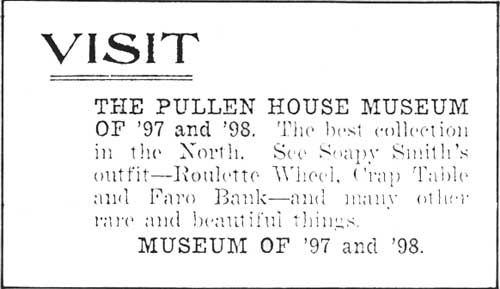
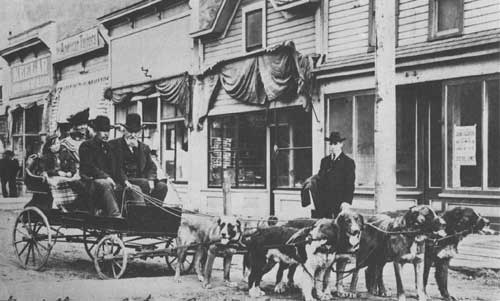
|
| Captain Moore riding shotgun in a unique dog-powered wagon; Harriett Pullen is seated in the back with a young fried, Broadway Avenue, about 1905. |
The number of tourists or "excursionists" increased, especially during the grand ocean cruise days of the 1920s and 1930s. To cater to these visitors, the major steamship lines and the White Pass & Yukon Route railroad extolled the gold rush flavor of this small town at the head of the enchanting Lynn Canal. When passengers arrived in Skagway, they were greeted by an assortment of characters left over from the stampede days — Martin Itjen and his "Streetcar" tour, "Ma" Pullen of the Pullen House, the actors in the first "Days of 98" shows, and the proprietors of a string of curio shops. Three of these shops remain, at least in name.
These individuals worked to keep alive the spirit and appearance of Skagway, which at that time was in one of its lowest economic periods. They also initiated a second preservation period. Martin Itjen preserved the saloon of Soapy Smith and the home of Frank Reid, as well as caring for the Gold Rush Cemetery grounds — of course, these were major stops on his tour. Ma Pullen, the Kirmses, and other town-folk collected and prepared memorabilia for their small and large museums. Although many of the early structures were falling to ruin, the Broadway Avenue corridor of buildings was maintained as a picturesque front for tourists traveling by railroad or foot up the main street.
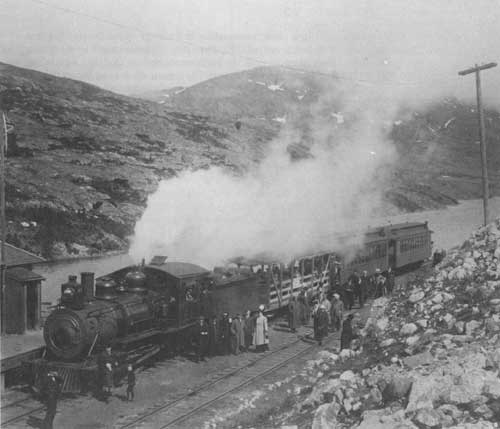
|
| Excursionists on a 1906 White Pass run. Note the converted, open car. (Photo courtesy of Library of Congress) |
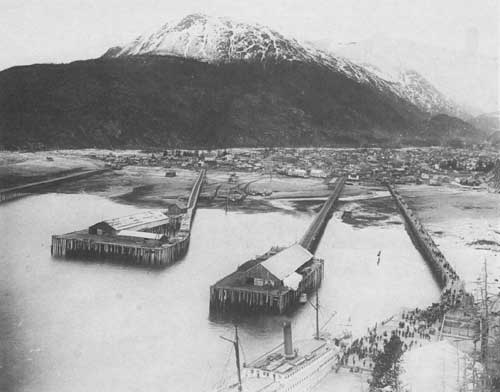
|
| Excursionists from a cruise ship docked at Moore's wharf in 1901 when Skagway was at its peak. |
The first public efforts to create a national park began during the 1930s, but the four-man committee which petitioned the Department of Interior in 1934 met with no success. However, national sensitivity for historic preservation was developing, and in 1935 (and again in 1966) Congress passed major pieces of legislation that called for identification, protection, and enhancement of historic properties.
World War II precluded any potential for further inquiry. At the same time, Skagway's tourism industry collapsed. By the end of the 1940s, the pioneers — the Itjens, Ma Pullen, and others — had passed from the scene.
Following a period of stagnation, the preservation of Skagway took a more serious turn. The residents were no longer satisfied with eulogies for demolished buildings, and during Mayor Cy Coyne's tenure in the 1950s, they began to seek attention for the national landmarks in their community. The city established a historical commission and requested another look by the National Park Service. Local groups and the mayor's historical commission, aided by state groups, succeeded in placing Skagway on the National Register of Historic Places (an official list of cultural resources in the United States that are worthy of preservation) on June 13, 1962, as the "Skagway and White Pass National Historic Landmark." This status enabled local property owners to obtain federal and state historic preservation loans and grants. Buildings along Broadway were repainted. Shops were reopened.

|
| White Pass and Yukon Route old depot complex prior to restoration, photo taken in 1979. |
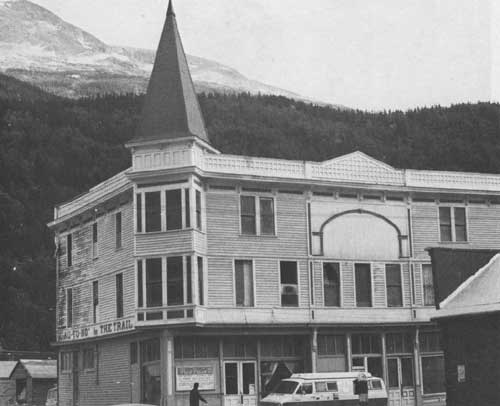
|
| Trail Inn/Pack Train Saloon, Broadway Avenue; preservation is now underway. |
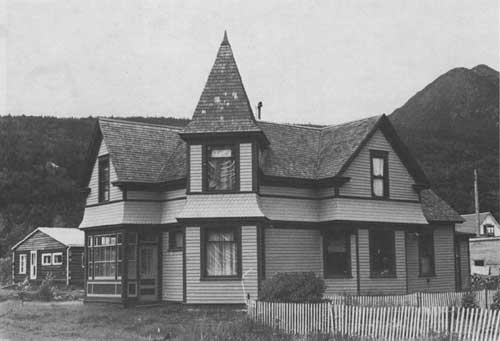
|
| Historic Case home; preservation underway. |
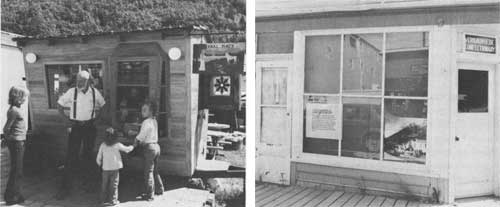
|
| Broadway Avenue in 1980. |
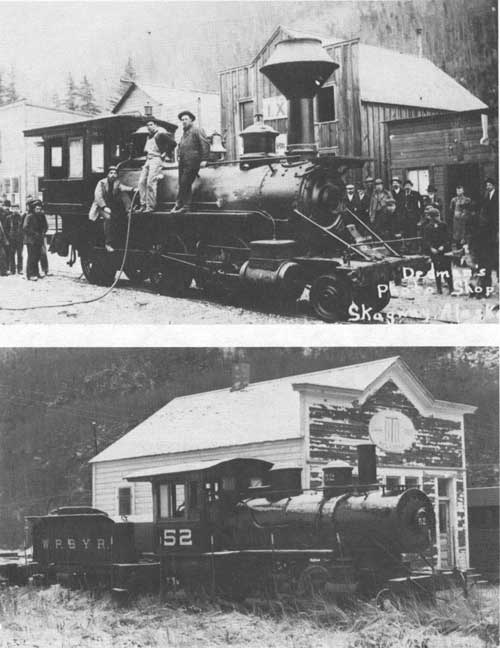
|
| WP& Y Route locomotive, then (1898) and now (1979). One of the first two locomotives remains in Skagway, the other is in Whitehorse. (Older photo is on a postcard from Dedman's Photo Shop). |
Meanwhile, certain individuals were actively preserving Skagway's past. George Rapuzzi took over Martin Itjen's role as the caretaker of Soapy Smith's parlor and innumerable artifacts. Unfortunately, Ma Pullen's museum was lost to Seattle auctioneers; local and state efforts failed to purchase all but select items. This failure, however, was counterbalanced when the townfolk succeeded in collecting and preserving objects for a city-run museum (The Days of 98 Museum, located in City Hall). The White Pass & Yukon Route railroad participated in these preservation efforts by donating two locomotives for static display.
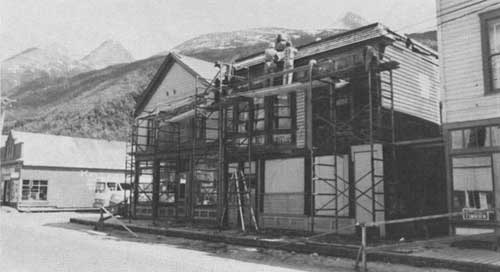
|
| Painting the Mascot Saloon, 1980. |
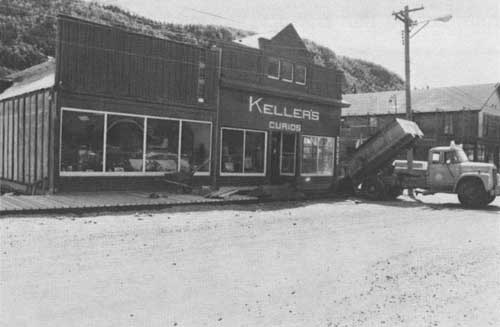
|
| Keller's Curios foundation work, Broadway, 1980. |
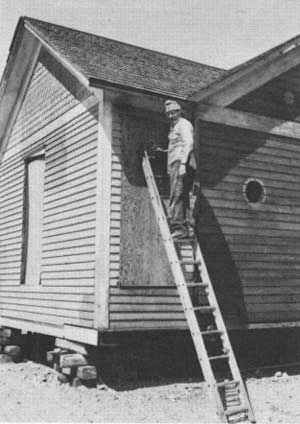
|
| Preparing the Itjen House for painting, 1980. |
The White Pass & Yukon Route company also donated the old depot to the National Park Foundation in 1969 and thus encouraged the revival of the 1950s proposal to have a national park established in Skagway. A series of National Park Service planning documents followed, and in 1976 President Gerald Ford signed the enacting legislation for Klondike Gold Rush National Historic Park. On June 4, 1977, the park was dedicated. The National Park Service currently administers the park lands and acts as a partner in the preservation of Skagway's Historic District.
The preservation of Skagway, started much earlier, gained considerable momentum. But, in a sense, the preservation of Skagway has just begun. Buildings are being jacked up and placed on concrete foundations, replacing the rotted wood pier foundations of the gold rush. Facades are being painted, buildings cleaned up and reused, and new roofs added. With much work, Skagway's physical presence may continue with us, allowing future generations to empathize with the dreams of the stampeders.
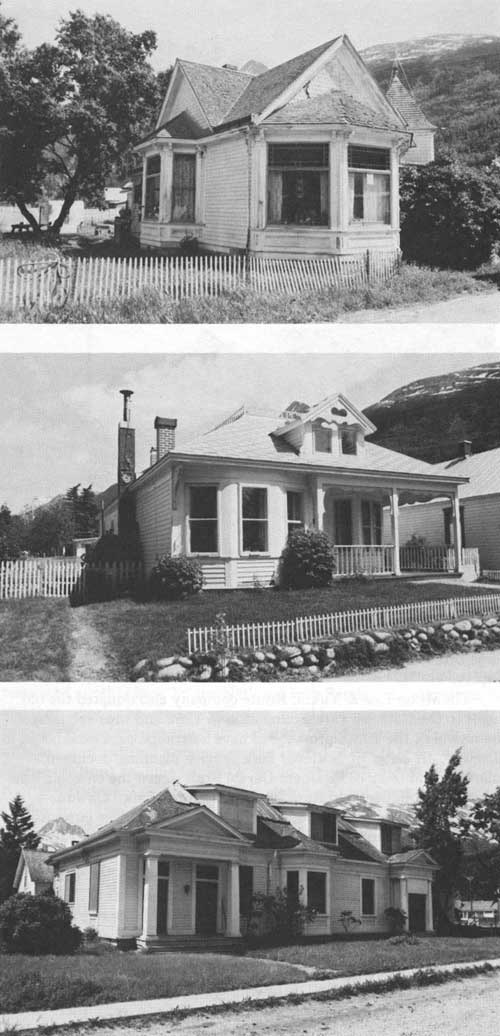
|
| Skagway residences today. |
| <<< Previous | <<< Contents>>> | Next >>> |
klgo/hpd-36/chap6.htm
Last Updated: 06-Aug-2009